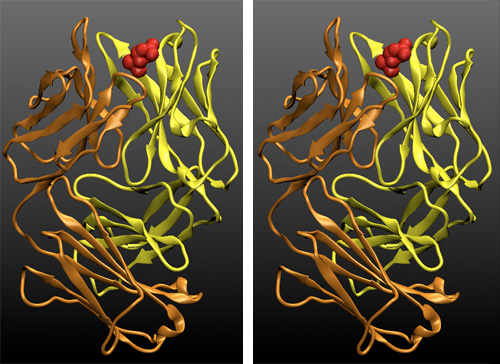Difference between revisions of "Stereo Vision"
| Line 51: | Line 51: | ||
*Practice this patiently, two times daily for some 3 to 5 minutes. Stop, when your head feels funny. Don't force yourself. | *Practice this patiently, two times daily for some 3 to 5 minutes. Stop, when your head feels funny. Don't force yourself. | ||
| − | It should take you about a week to master this, with regular training it will become very easy. And, the best thing is, you do not easily forget this skill. It is like riding a bicycle, equalizing pressure in your | + | *After time and with practice, it will become easier and easier to achieve the effect. Also you will become quite independent of the distance of equivalent points, thus you can increase the viewer window size and take advantage of the increased resolution. |
| + | |||
| + | It should take you about a week to master this, with regular training it will become very easy. And, the best thing is, you do not easily forget this skill. It is like riding a bicycle, equalizing pressure in your ears while scuba diving, or circular breathing to play the didgeridoo: once you teach your body what to do, it remembers. | ||
==Examples== | ==Examples== | ||
Revision as of 16:00, 14 September 2007
Contents
Introduction
Being able to visualize and experience strucutre in 3-D is an essential skill, if you are at all serious about understanding the molecules of molecular biology. This is not sufficiently realized in the field: many molecular biologists in the field have never invested the effort it takes to learn the skill and thus get by regardless. The catch is: unless you have experienced and worked with stereo images, there is no way of understand how much you are actually missing. But once you have used the skill, you'll regret not having been taught earlier. Seing molecules in 3-D is like the difference between seing a photograph of a place and actually being there. In 3-D you can apreciate size, scale, distance, spatial relations all at a single glance. I would claim: you can't understand structure unless you experience it in 3D.
Even though hardware devices exist that help in the three-dimensional perception of computer graphics images, for the serious structural biologist there is really no alternative to being able to fuse stereo pair images by looking at them. VMD is an excellent tool to practice stereo vision and develop the skill. Stereo images consist of a left-eye and a right-eye view of the same object, with a slight rotation around the vertical axis (about 5 degrees). Your brain can accurately calculate depth from these two images, if they are presented to the right and left eye separately. This means you need to look at the two images and then fuse them into a single image - this happens when the left eye looks directly at the left image and the right eye at the right image.
Some people find convergent (cross-eyed) stereo viewing easier to learn. I recommend the divergent (wall-eyed) viewing - not only because it is much more comfortable in my experience, but also because it is the default way in which stereo images in books and manuscripts are presented. The method explained below will only work for learning to view divergent stero pairs.
Physiology
In order to visually fuse stereo image pairs, you need to override a vision reflex that couples divergence and focussing, this is something that needs to be practiced for a while. Usually 5 to 10 minutes of practice twice daily for a week should be quite sufficient. It is not as hard as learning to ride a bicycle, but you need to practice regularily for some time, maybe 10 or 20 sessions of 3 to 5 minute over a period of a week or two. Once you have acquired the skill, it is really very comfortable and can be done effortlessly and for extended periods. You will enter a new world of molecular wonders !
Instructions
Here are step by step instructions of how to practice stereo-viewing with VMD.
- Load a small protein into VMD (1UBQ will work just fine) and display this as a simple backbone model.
- VMD Main → Representations → Drawing Method: Tube
- Increase the tube radius to 1.0; choose coloring by Index.
- Set the stereo display to SideBySide:
- VMD Main → Display → Stereo → SideBySide
- Resize the window, until two equivalent points on the protein are the same distance on the screen as the pupils of your eyes are apart (the average interocular separation is about 6.5 cm). Don't just guess, measure the distance, and adjust your on-screen scene to better than two or three millimetres of the correct separation.

You should resize the window of your molecular viewer (VMD) until equivalent points are the correct distance apart, they should match as nearly as possible your interocular separation. The two circles indicate equivalent points of the image. They are 232 pixels apart, their physical separation on the screen depends on your monitor resolution. On my screen they are 5.2 cm apart, too close for most people.
- Touch your nose to the screen and look right at the two images. Make sure you see the right image with your right eye, the left with your left eye. Of course, since you are so close, the images will be blurred and out of focus. Nevertheless, you should see one solid, three dimensional shape in the centre, two peripheral images of the same on the sides. Actually you see three copies of the same scene, but only the fused, centre scene appears three-dimensional; the other two become less noticeable as you practice more, your brain simply begins editing them out. Slowly rotating the protein with the mouse helps generate the impression of a 3-D object floating before you. (With VMD you can use the mouse to give the molecule a slow spin and it will continue to rotate).
- Once you see the object in 3-D, try to move your head backwards slowly, until the structure comes into focus by itself. Do not voluntarily try to focus, since this will induce your eyes to converge and you will lose the 3-D effect. After a short while, you will probably lose the 3-D effect. Once you lose the 3-D effect, pause, look somewhere else and start over.
- Practice this patiently, two times daily for some 3 to 5 minutes. Stop, when your head feels funny. Don't force yourself.
- After time and with practice, it will become easier and easier to achieve the effect. Also you will become quite independent of the distance of equivalent points, thus you can increase the viewer window size and take advantage of the increased resolution.
It should take you about a week to master this, with regular training it will become very easy. And, the best thing is, you do not easily forget this skill. It is like riding a bicycle, equalizing pressure in your ears while scuba diving, or circular breathing to play the didgeridoo: once you teach your body what to do, it remembers.
Examples
Here are example scenes to practice stereo viewing. You could also refer to the Stereo Vision Exam Questions.

Side by side stereo image. The two chains of the Fab fragment of the phosphocholine-binding antibody McPC603 are shown in a cartoon representation, the light chain is in yellow (VL and CL domain), the two domains of the heavy chain are shown in orange (VH and CH1 - The CH2 and CH3 domains are part of the Fc fragment, not shown here). The hapten phosphorylcholine is shown in red in a surface representation.
Common problems
There are two situations which interfere strongly with stereo vision. One such situation is if the images presented to your eye are of unequal size. This can happen if you are using glasss with significantly different correction for each eye - the lenses then have different magnifications. The other situation is if equivalent points of the images are verticaly misaligned, i.e. one of the images is shifted up or down, or rotated. This can occcur when your head is tilted relative to the image. Keep it straight.
Images that are difficult to see in 3-D are also images that are rendered slightly differently for both views: non-aligned jagged edges, differing shadows or highlights disturb the stereo effect. Thus, try to keep the number of visual effects low; if you are a programer, remember to write your code to move the camera location, don't rotate the object because that will incorrectly change shadowing.
Resources and References
- Stereopsis - Wikipedia article on why we see in three dimesions
- Stereoscopy - Wikipedia article on the techniques for stereo images


